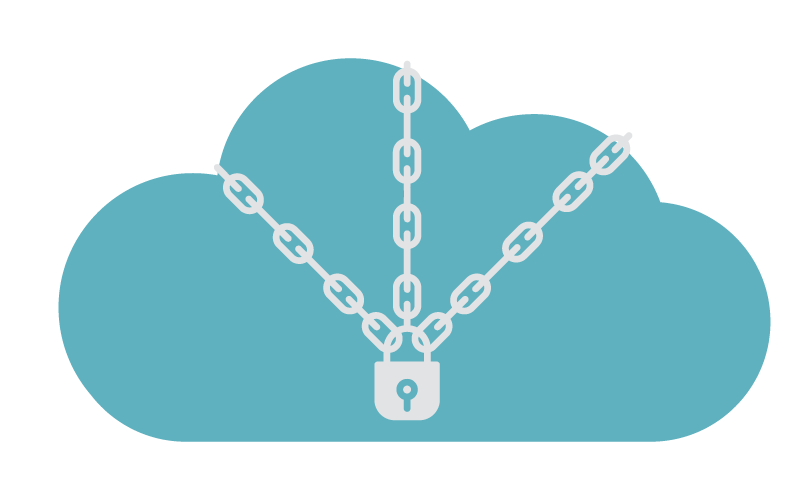The multicloud architecture model involves using two or more public cloud computing services, such as Amazon Web Services (AWS), Microsoft Azure, or Google Cloud Services, while it can also mean that a company combines private cloud computing assets with public cloud platforms. The multicloud environment is different from the hybrid cloud model as it refers to multiple cloud services instead of multiple deployment modes (public, private, legacy). It also minimizes the importance of synchronization between different vendors for completing computation processes, as opposed to parallel computing or distributed computing environments where this is not the case.
Globally, both enterprises and SMBs have started to increasingly adopt multicloud environments. According to Gartner, more than 80% of organizations are now multicloud, due to multiple benefits, some of which include:
- more efficient distribution of computing resources
- reduced risks of service interruption
- reduced risks of data loss
- improved security
- improved proximity to customers
- improved DevOps workflows
All these advantages are made possible through the standardization of services and tools that are not tied to a specific cloud, thus leveraging the supremacy of best-in-breed services as well as the delivery of full backup capabilities across the entire application tier and lifecycle, which immensely simplifies compliance and improves business risk management.
Benefits Of Using the Multicloud Approach
Improved Agility by Choosing Best-in-Breed Multicloud Providers & Services
In order to design an optimal IT strategy, administrators must take into account numerous factors – cost efficiency, reliability, performance, etc – and make sure all their business requirements and individual tasks are lined up with what a certain cloud-hosting provider has to offer. With the multicloud approach, this is made possible as you can combine services from multiple platforms according to your unique needs. For example, a company can select one cloud provider for its high upload speed, and choose another for more favourable Service Level Agreement terms, and so on.
This means that, instead of changing your own workflow and altering your own processes to accommodate a provider’s requirements, you can access various options from multiple providers and thus tailor all the services so they best match different parts of your business. When approached with the right expertise and guidance, multicloud enables you to achieve high agility levels and improved workload mobility between heterogeneous cloud platforms, storage, and hypervisors.
More Data Center Options
The quality, speed, and reliability of data centres vary depending on hardware age, connectivity, other tenants, etc. Typically, data centres with newer hardware are more reliable and enable faster running of cloud applications, while some may feature higher levels of global internet connectivity due to the use of higher-capacity fibre links. Also, depending on who the other tenants are and their activity, your app performance may be suboptimal during specific timeframes.
Multicloud environment and a proper strategy enable companies to choose data centres with optimal geolocation, performance and connectivity, and – quite conveniently – switch between data centres if one of them is underperforming.
Cover All the Bases for Success in the Cloud
Let's create a tailored cloud strategy that takes into account your needs across technology, business, and development.
Let's goImproved Proximity to Key Markets and Customers
Multicloud allows you to run app infrastructures as close to your target consumers as possible thanks to cloud providers offering data centres in high proximity to your key markets. When this is the case, your app is likely to run faster as a result of low-distance data centres. Additionally, in scenarios in which global Internet issues occur, the application running on multicloud is less likely to face downtime and can continue to deliver locally with less exposure to potential connectivity issues.
Faster Recovery and Increased Resilience
Companies that run multicloud environments typically create system replicas to improve resilience and speed up recovery time. These replicas are made for app delivery, data tier, and compute tier, and are done across multiple clouds, enabling them to afford N+1/N+2 resilience and allow rapid failover should one cloud fail to deliver. Running your systems and applications in multiple clouds enables you to have (almost) instant failovers, mitigating potentially catastrophic failures through swift recovery.
Minimizing Vendor Lock-in

Vendor lock-in happens when a business runs its application through a single cloud platform, which may lead to quite expensive business decisions in the long run as you never know when your provider may double the price of its widely used relational databases, for example. More issues can occur if one or more critical services get neglected by the cloud provider, causing you to struggle with keeping up with the market trends. Not to mention the possibility of a cloud provider choosing to EOL (end-of-life) their product and/or service that is critical for your app.
These scenarios can result in huge bumps in infrastructure costs, as well as the need to move your app(s) from that service, which is always a time-consuming and quite expensive task. Luckily, moving onto a multicloud infrastructure obviates these scary scenarios as your business isn’t putting all the eggs in a single basket.
Multicloud Best Practices All SMBs Should Consider
Despite numerous benefits that can be reaped from the multicloud model, it is important to understand that this approach cannot solve all the issues that SMBs or enterprise-level companies may come across. On a similar note, there is no one-size-fits-all multicloud strategy that would work for all businesses and across all industries. Each organization should design its own multicloud plan and roadmap that is optimal for its unique processes, workflow, and business needs.
That said, there are still best practices that could be followed and implemented in order for a business to achieve long-term success.
Map Your Workloads Across Multicloud Services
Each component of your company’s workflow and workload should be logically mapped across the ecosystem of multicloud services available to you. This mapping process, when executed in an optimal manner, enables businesses to allocate proper infrastructure components and cloud services to appropriate business needs.
The process also allows IT teams to define SLAs (service-level agreement) that are optimized according to their specific requirements in terms of:
- data privacy
- availability/uptime
- latency
- rapid scalability
- real-time streaming
- batch processing
- etc.
Create an All-encompassing Integration Framework
The integration plan for multicloud environments can be a rather complex procedure due to multiple integration points between data stores, third-party cloud-based services, applications, on-premise systems, and so on. In order to aggregate data across multiple cloud platforms, services, tools, as well as on-premise legacy infrastructures, it is recommended that you create custom APIs and integration tools.
Reduce Business Risk by Streamlining Vendor Management
The basic premise of the multicloud model is using a wide range of technology vendors for the following:
- cloud infrastructure
- SaaS applications
- DCs
- mobile apps
- colocation services
- QA/testing teams
- application development companies
- SOCs/NOCs
- service providers
This often convoluted ecosystem of multiple vendors and vendor management tasks can lead to rigid departmentalization effects that may result in reduced control and increased business risks. This is why making sure that the vendor management aspect of your multicloud strategy is as tight as possible, so as to minimize risks in the long run.
Cost Optimization

This is a challenging yet critical task. Make sure that you have a clear overview of all the costs and accounting tasks for each and every expenditure across all services, tools and providers. The abovementioned mapping process is a prerequisite for this task, as it will help you track the deployed services and define their individual monthly or annual costs. These metrics enable you to determine how much time your teams spend using and managing specific services and tools, allowing you to have actionable insight into exactly how cost-efficient certain services are for your business. This cost optimization process should also include metrics like traffic costs, integration expenses, use of labor, etc.
Develop Detailed and Consistent Security Policies
Infrastructure security and data privacy should be one of the core areas of concern during the multicloud adoption process. When you deal with a diverse spectrum of services and IT resources, it is critical to keep everything as secure as possible and do so on both infrastructure level as well as for more granular use of data. Be sure to secure your company’s entire perimeter, which includes:
- applications
- data sources
- users
- endpoints
The more complex your ecosystem of services, apps, data sources and users is, the more detailed your approach to security must be. This is why it is recommended that IT decision-makers come up with centralized, standardized and consistent security policies across an entire company. Bear in mind that this may require partnering with certain managed security service providers (MSSPs) in order to better unify the entire security-focused cloud environment.
Update Your Disaster Recovery Strategy
Depending on the size of your company and the number of projects, DR strategy implementation may need to have 3 different points of approach:
- DR for the migration process
- Multicloud environment DR
- DR for new requirements (CI/CD)
DR for the migration process – when a business migrates onto a multicloud system, one of the biggest challenges is moving on-prem workloads and existing systems to cloud-based environments. This process can be risky in terms of uptime and business continuity, which is why it requires meticulous step-by-step planning.
Multicloud environment DR – multicloud and legacy on-premise systems require different approaches to DR strategy. As the former feature more complex IT environments – thanks to multiple dynamic parameters, deployment models (SaaS/IaaS), scalability, workload nature, data types, geographical coverage, services, etc – it is highly recommended that your multicloud DR is equally granular.
DR for new requirements (CI/CD) – high scalability and agility levels of multicloud systems require CR setups to be equally adaptable. This is why it is recommended to have an optimized continuous integration and continuous delivery approach that can handle the ever-evolving fast-changing IT landscape.
Rounding Up
Multicloud environments offer a plethora of advantages to SMBs, not to mention enterprise-level companies. However, to leverage most of these benefits, a company must understand all the underlying tasks, procedures and potential challenges that these architectures and services may involve.
Depending on the size of an organization, as well as the industry it belongs to, moving onto multicloud systems can be an unsurmountable project that often leads to unnecessary costs without proper payoffs. To mitigate this scenario and come up with an effective multicloud infrastructure strategy, we highly recommend consulting cloud enablement experts capable of helping you along the way.
